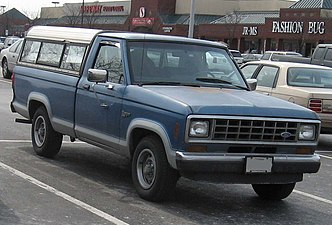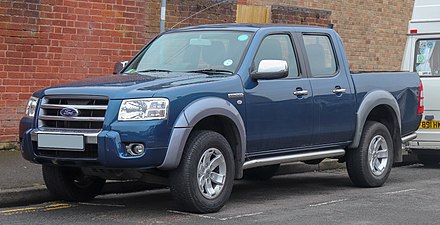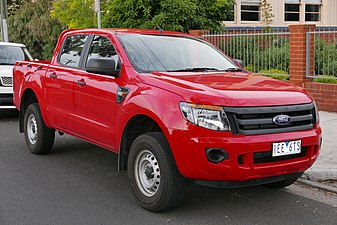Page version status
The latest pending revision is displayed on this page
Ford Ranger is a nameplate that has been used on several model lines of vehicles sold by Ford. Used exclusively for pickup trucks, Ford has produced the Ranger since the 1983 model year; each version of the Ranger has replaced the Ford Courier compact pickup truck produced by Mazda. In North America, the Ranger is slotted below the Ford F-150 in the Ford light truck range, serving as the smallest Ford pickup truck. In markets where the Ford F-series and Super Duty trucks are not marketed, the Ranger is usually the only pickup sold by Ford.
In the Americas, the model line is currently in its fourth generation, derived from the third generation of the Ranger marketed worldwide. Initially designed by Ford Australia, the Ford Ranger T6 is the first version of the Ranger that is a mid-size pickup truck.
Origin of name
Prior to its use on compact trucks, Ford Motor Company used the Ranger nameplate on three different model lines. The name made its first appearance in 1958 as the Edsel Ranger; serving as the base-trim sedan for the division, the Ranger would be produced through the 1960 model year. Within the Ford brand, the Ranger name began use as a trim package on Ford F-Series trucks in 1965 and the Ford Bronco SUV in 1972, serving as a mid to top-trim level until 1981.
Following the 1981 model year, Ford withdrew the Ranger trim line from its light trucks, largely in anticipation of its 1983 compact pickup truck.
Americas (1983–2012, 2019-present)
Main article: Ford Ranger (Americas)For the 1983 model year, Ford introduced the Ranger for the United States and Canada. Replacing the Courier (a rebadged Mazda B1800), the Ranger was the first compact pickup truck designed by Ford. Using the same chassis architecture, three generations of the Ranger were produced across its 29-year production run. The model line underwent major redesigns for 1993 and 1998, a mid-cycle update in 1989, with smaller updates for 2001, 2004, and 2006.
The Ford Ranger chassis architecture served as the basis for several model ranges over its production. The Ford Bronco II and the 1991-2001 Ford Explorer were derived from the Ranger (alongside the Mazda Navajo and Mercury Mountaineer) alongside the 2001-2005 Ford Explorer Sport Trac. Through the use of rebadging, in North America, Mazda sold the Ranger as the Mazda B-Series from 1994-2009 (the reverse of the original Ford Courier; also the reverse of the Ford Ranger outside North America).
On December 22, 2011, the final Ford Ranger produced for North America rolled off the Twin Cities Assembly line, as the final vehicle assembled at the facility.
South America (Ford Argentina)
In 1995, exports of the Ford Ranger began to select Latin and South American countries. To accommodate the demand for the vehicle, in 1998, Ford Argentina commenced local production of the Ranger, introducing a four-door cab not sold in North America. During the 2000s, Rangers produced by Ford Argentina shared a common chassis with North American-produced vehicles (offering a diesel engine to meet local demand). For 2010, the Ranger underwent a major revision of the exterior (not done for North America).
Ford Argentina ended production of the compact Ranger following the 2011 model year (slightly before the United States) to expand production of the Ranger T6 mid-size pickup, which remains in production.
Model revival (2019–present)
For the 2019 model year, Ford returned the Ranger to its model range in North America (after an eight-year hiatus); the first example rolled off the assembly line on October 22, 2018. A version of the global Ranger T6 adapted to accommodate American government regulations, the 2019 Ranger is the first generation sold in North America as a mid-size pickup truck. Similar in size to the Ford Explorer Sport Trac, the Ranger is sold in two configurations, a 2+2 door SuperCab (6-foot bed) and a 4-door SuperCrew (5-foot bed); the two-door standard cab is not offered for sale in North America (nor is the Ranger Raptor).
The model line is currently produced by Ford at its Michigan Assembly Plant at Wayne, Michigan.
-
 First generation (1983–1988)
First generation (1983–1988)
-
 First generation facelift (1989–1992)
First generation facelift (1989–1992)
-
 Second generation (1993–1997)
Second generation (1993–1997)
-
Third generation (1998–2000)
-
 Third generation, first facelift (2001-2003)
Third generation, first facelift (2001-2003)
-
Third generation, second facelift (2004-2006)
-
 Third generation, third facelift (2006–2012)
Third generation, third facelift (2006–2012)
-
 Third generation, fourth facelift (South America, 2010–2012)
Third generation, fourth facelift (South America, 2010–2012)
-
 Fourth generation (2019–present)
Fourth generation (2019–present)
International (1998–present)
Main articles: Ford Ranger (international) and Ford Ranger (T6)Ford entered the compact truck segment in 1971 by marketing the second-generation Mazda B-Series under the Ford Courier nameplate. Since 1983, Ford replaced the Courier in North America with the Ranger, while continuing to rebadge Mazda B-series trucks in global markets as the Courier into the 1990s.
In 1998, the Ranger nameplate replaced the Courier nameplate, except for Australia and New Zealand where the Courier nameplate continued to be used until 2006. As with the Courier, the international Ranger followed the model development of the Mazda B-series. The first-generation Ranger was produced from 1998 to 2006, while the 2006–2011 second generation Ranger was introduced after the B-Series was replaced by the Mazda BT-50.
The globally-marketed Ranger T6 has been produced since 2011. In contrast to previous versions, the T6 was designed by Ford Australia (with the second-generation BT-50 derived from it). After excluded from sale from the United States and Canada since 2011, the Ranger T6 has been marketed in North America since 2019 with several design adaptations and modifications.
-
 First generation (1998–2002)
First generation (1998–2002)
-
 First generation (2002–2006)
First generation (2002–2006)
-
 Second generation (2006–2009)
Second generation (2006–2009)
-
 Second generation facelift (2009–2011)
Second generation facelift (2009–2011)
-
 Third generation (2011–2015)
Third generation (2011–2015)
-
 Third generation facelift (2015–present)
Third generation facelift (2015–present)
References
- Max, Josh (19 December 2011). "Ford Ranger, other cars, cease production in 2012". New York Daily News. Retrieved 26 December 2014.
- "2019 Ford Ranger production starts in Michigan". Roadshow. 2018-10-22. Retrieved 2018-10-23.
If an internal link incorrectly led you here, you may wish to change the link to point directly to the intended article.
| Ford vehicles | |||||||||||||||||||||||
|---|---|---|---|---|---|---|---|---|---|---|---|---|---|---|---|---|---|---|---|---|---|---|---|
| Current models |
| ||||||||||||||||||||||
| Former models (by date of introduction) |
| ||||||||||||||||||||||
| Military | |||||||||||||||||||||||
| Related topics | |||||||||||||||||||||||